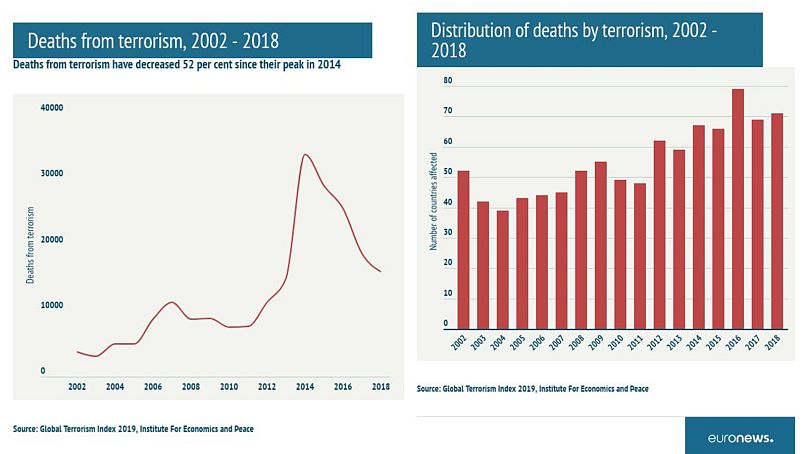2018 saw the fourth consecutive drop in terrorism deaths — but the problem is increasing around the globe, as Institute for Economics and Peace MENA director Serge Stroobants explains.
Deaths from terrorism are decreasing but the worldwide threat has spread to include more countries, according to the latest Global Terrorism Index.
The study, published by the Institute for Economics and Peace, has also identified an increase in far-right violent activity over the past 5 years.
During the report’s Middle East launch in the UAE capital Abu Dhabi, Serge Stroobants, the Institute’s Director for MENA and Europe, spoke to Euronews about the latest findings.
## Decrease in deaths, but spreading threat
## The study states that the number of deaths from terrorism in 2018 fell to 15,952, a 15% drop compared to 2017. This is the fourth consecutive year that a decrease in terrorism-related deaths has been identified.
Europe and the Middle East and North Africa region have accounted for the largest improvement, with the number of fatalities in a year falling by 70 per cent and 65 per cent respectively.
Despite the decline in global casualties, the report also shows that the number of countries affected by terrorism remains high, with 71 countries being impacted in 2018.
This is the second highest figure since 2002.
According to Stroobants, this shows that although security tactics and intelligence services have improved, violent ideology is spreading.
“We have been really, really good, especially in the West, in tackling the capabilities of those international groups, basically taking away the capabilities they had to harm us,” he told Euronews.
“But we’re not so good at really tackling the root causes of the phenomenon and of a potential cause of radicalisation. There must be a larger investment in the prevention of violent extremism rather than just countering it,” he added.
Which countries are most and least impacted?
Afghanistan, Iraq, Nigeria, Syria and Pakistan top the list of the countries most impacted by terrorism globally.
The Middle East and North Africa is the region most affected by terrorist activity, followed by South Asia and sub-Saharan Africa.
The report shows that 93 percent of all deaths related to terrorism between 2002-2018 occurred in these three regions.
Nevertheless, some countries in the Middle East and North Africa region have also made it to the lower rankings of impacted countries, including the United Arab Emirates, Qatar and Oman.
In Europe, Turkey, Ukraine, United Kingdom, France and Russia are the most impacted, whilst the least affected include Belarus, Croatia, Slovenia, Portugal and Romania, which tie at the bottom of the rank with an index of zero.
Perception of vulnerability
## According to Stroobants, the focus of media coverage on terrorist incidents in Western countries points to how attacks on other regions may be perceived as “almost routine”.
“When you look at the regions most impacted, […] when terrorist attacks happen there, it's very lethal, but it's also almost routine, […] so you will get coverage, but not full media coverage,” he told Euronews.
“When a European country or Western country gets targeted by terrorist attack, I think that the perception of insecurity and vulnerability would be much higher in those countries because they are assumed to be very, very secured,” he added.
Stroobants. who is Belgian, cited the example of the Brussels attacks in March 2016, which brought global media coverage in country for over a week.
“In this week, a multitude of other attacks occurred in many, many other parts of the world, generating many, many more casualties than the 32 casualties from Brussels, so I can just imagine all those people in other parts of the world would feel if we focus only on Brussels while their relatives, their nationals were also getting killed,” he said.
## Increase in far-right activity
The study has shown a significant rise in terrorist incidents related to the far-right movement — a 320 percent increase over the past five years.
### Read more: Far-right terrorism on the rise in the West, bucking global terror trends
Whilst far-right terrorism remains a small fraction of terrorism worldwide, Stroobants believes its rapid increase is a cause for concern.
“We’re talking around 30 casualties in 2018, so that's marginal compared to the 16,000 casualties worldwide in 2018, but the speed and the strength of the increase is really worrisome and we need to keep a close eye,” he said.
Stroobants went on to say that far-right terrorists mostly act on their own and are not associated to a larger group or organisation, which makes it harder for security forces to anticipate incidents.
“We do not really see a large organisation claiming those attacks," he told Euronews. "So, it's very, very difficult to to start acting against all those persons because it's really those individuals who are educating themselves in this type of ideology, and then using violence at some point. That makes it very, very difficult for security and intelligence services to identify potential actors.”












